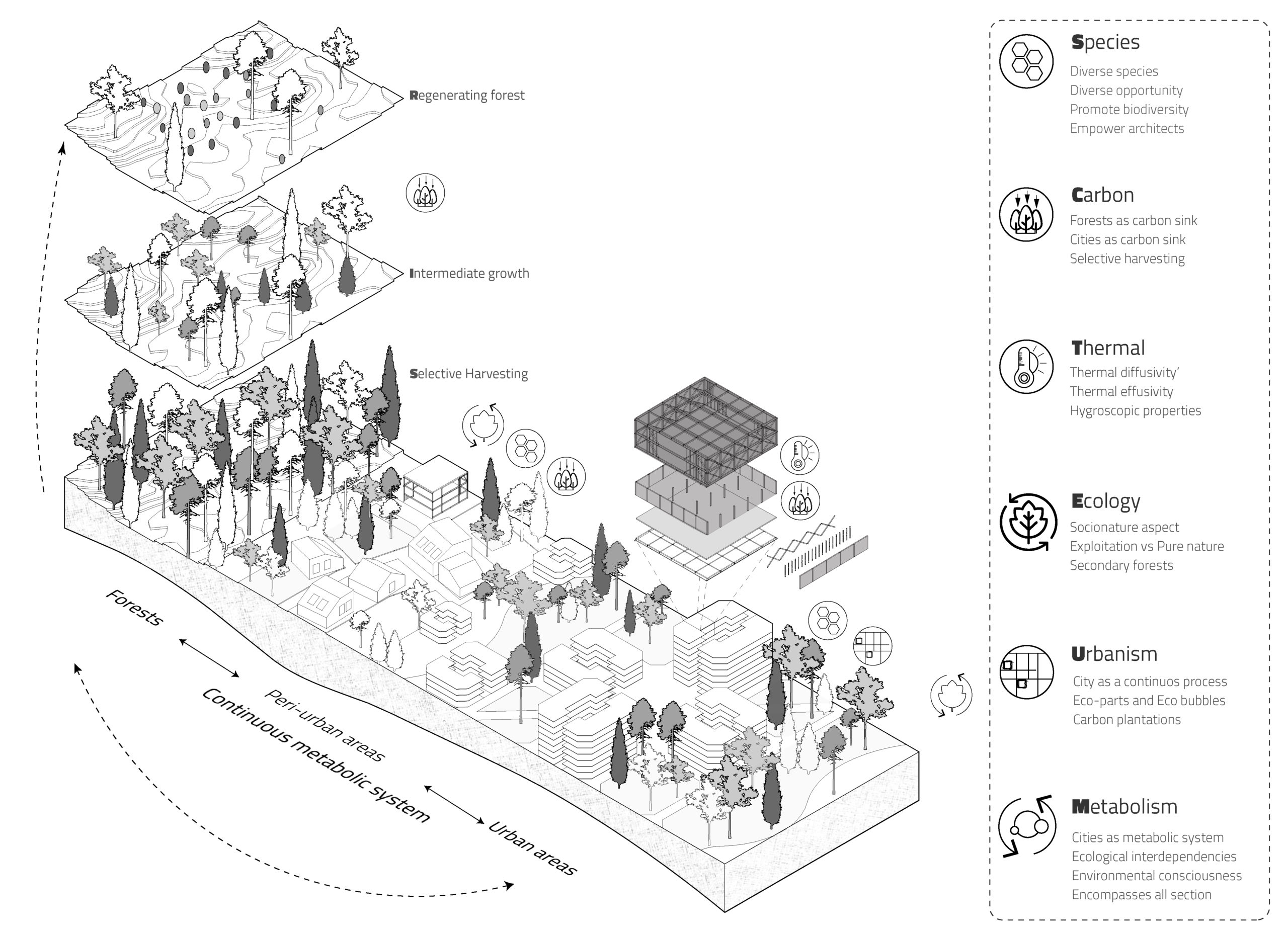This blog is a review of the book “Wood urbanism” by Daniel Ibanez, Jane Hutton & Kiel Moe. Wood urbanism addresses different scale and connection associated with timber building- From molecular to Territorial, divided in six chapters. The transcalar perspective of wood construction from understanding the strength of individual species according to its place in the forest, its contribution in carbon sequestration as a tree as well as a timber building, its thermal properties, its socio-political aspect and wood as a process of urbanization articulates the present and future architectural and ecological potential of wood.
- SPECIES:
This chapter talks about different species of wood, their unique character according to their place and behavior in forest & its use value in material, implement & value. Disregarding the material’s diversity is to ignore the complex landscape entanglements, and unique strengths and opportunities it provides. Instead of following the current trend of mass plantation and harvesting of a single species to cater to the timber demand, the variety must be increased to promote biodiversity in the forests they are sourced from. This, combined with sustainable forest management strategies can be used to maintain a good balance in the natural ecology while also promoting the ecological services provided by the forest to create a sustainable built environment. This poses challenges that require new research and tests for undervalued species but will promote biodiversity and reliance on regional sources. It will also require a change in policy and educational level, to empower architects to make the specifications according to the species’ availability in the region, and the structural and aesthetic requirements.
- CARBON:
Trees sequester carbon in their lifetime, absorbing carbon from the atmosphere and storing it in their mass until it burns or decomposes when the carbon is released back into the environment. 50 % of wood’s dry weight is carbon. Clear cutting forests for timber usage without replantation is not carbon negative. So, the chapter again echoes the importance of sustainable forest management strategies and maintaining the balance between taking from and giving back to nature. Selective harvesting of trees allows more space and resources to the surrounding trees- the extraction of locked carbon in the cut tree allows higher sequestration of carbon by growth of healthier trees. Forests have the potential to remove and store a significant amount of the excess CO2 now in the atmosphere, and therefore play a significant role in our planet’s ability to regulate warming and carbon emissions.
- THERMAL:
Wood is an anisotropic material– with varying characteristics in different axes. The chapter talks about the latent thermal and hygrothermal properties of wood- through the relationship of conductivity to specific heat, effusivity and density. The chapter connects with other chapters of the book when we stop seeing the thermal property of wood in isolation- the carbon cycle of buildings is affected by the thermal capacities of a timber building. Other than the thermal properties of wood as a construction material, the chapter also addresses its use as biomass for heating and cooling purposes. The byproducts generated from construction wastes can be used for such purposes, minimizing waste and ensuring the complete use, reuse and recycling of all products and in the end it goes back to nature.
- ECOLOGY:
The chapter addresses the social and biophysical complexity of wood production landscapes. The ecosystemic services that forests provide go beyond just the production of a single commodity– local wood. Understanding these services- provisioning, regulating, cultural services and supporting services for biodiversity as complex and globally significant also makes it a strong basis for marketing within green capitalism. The socionature perspective of forest is also highlighted in this chapter- social practices of human inhabitation in forests.
Looking at forest through the lens of two contrasting paradigms “exploitation” and “pure nature” creates a division between man and nature. Instead, incorporating indigenous people and their knowledge in managed rural forests and plantations could be a better approach. The concept of secondary forests as a balance between the two paradigms can be applied in different scales- as peri urban forests providing ecosystemic service and as a green public space in cities to promote biodiversity and connection with nature.
- URBANISM:
“Urbanism” talks about the city as an object vs. city as a process. There are climate benefits of sequestering atmospheric carbon within long-lived timber products – the different components of the cities like timber buildings as well as open spaces can act as carbon sinks. For example, delaying carbon emissions reduces cumulative climatic energy input, buys time for adaptation of both natural and man-made systems, reduces the possibility of reaching dangerous climate ‘tipping points’, and increases the potential for permanent storage through future technologies such as carbon capture and storage. Taking the idea of secondary forests and designing interactive green spaces as carbon plantations can be incorporated in urban reforms and making cities dual natured.
- METABOLISM:
This chapter talks about the city being a metabolic system- needs a permanent flow of energy and material to perform their daily function. The entire book, about seeing wood in transcalar level and understanding its importance in different phases can be understood as a metabolic process itself. The inputs from forests are the wood products as well as other ecosystem services fueling the process of construction and other activities in the city and finally the outputs again going back to nature, completing the circularity .The ecological interdependencies between neighborhoods, parks and cities are also highlighted- looking at wood as a material flow deeply embedded in the socio-ecological metabolism of cities. It also addresses the circularity of the material- from the woods to the wood through contexts of different scales and perspectives.

Prepared by: Disha Arora & Santwana Malakar, MAEBB 23

